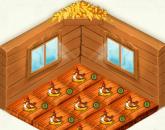Methodical materials for the lesson of geography. During the excursion, the students made a schematic sketch of the occurrence of rocks on a cliff near the river bank
F.I. __________________Option number 1
1. The shell of the Earth, including the earth's crust and upper mantle, is called:
a) the thermosphere;
b) asthenosphere;
c) lithosphere .
2. Igneous rocks were formed as a result of:
b) solidification of lava;
c) destruction of hard rocks;
3. On the surface of the Earth above the focus of an earthquake is located:
a) a volcano
b) a geyser;
c) a crater;
d) epicenter.
4. Rocks that have undergone changes under the influence high pressure and high temperature during the lowering of sections of the earth's crust, are called ...
a) metamorphic rocks
b) igneous rocks
c) clastic rocks
d) organic rocks
5. Tremors with oscillatory movements that occur during sudden displacements and ruptures in the earth's crust and mantle are called
a) volcanoes
b) earthquakes
c) tsunami
6. Indicate the number in the figure indicating the magma chamber.
7. A gushing source of hot water and steam is called
a) parent
c) a geyser
d) a key
8
9. The thickness of the earth's crust under the ocean:
a) 5-10 km;
b) 15-100 km;
10. A section of the earth's crust through which magma rises:
a) a volcano
c) a crater;
d) epicenter .
11. Igneous rocks include:
a) hard coal c) marble;
b) granite; d) sandstone.
12. The change in rocks under the influence of external forces is called
a) erosion
b) earthquake
c) weathering
13. What structure
shells of the Earth shown in the figure?
a) the continental crust;
b) the oceanic crust.
Test on the topic: “Rocks and minerals. The movement of the earth's crust "
F.I. __________________Option number 2
1. From hard materials and rocks consists of:
a) mantle;
c) the earth's crust .
2. Indicate the number in the figure indicating the product of a volcanic eruption.
3 . Establish correspondence between concepts and their definitions.
4 . The inner shell of the earth is called:
b) asthenosphere;
c) lithosphere.
4. Sedimentary rocks were formed as a result of:
a) accumulation of animal remains;
b) solidification of lava;
c) destruction of hard rocks;
d) increase in pressure and high temperatures at great depths.
6. What color are mountains painted on a physical map:
a) blue
b) green;
c) brown.
7. Volcanoes that erupt more or less regularly are called…..
a) sleeping
b) active
c) extinct
8. Metamorphic rocks include:
b) quartz;
c) basalt;
d) clay.
9. The epicenter of an earthquake is:
a) earthquake area;
b) earthquake source;
c) a point on the earth's surface
over the source of the earthquake.
10. During the excursion, the students made a schematic sketch of the occurrence of rocks on a cliff near the river bank.
Arrange the rock layers shown in the figure in order descending their age (oldest to youngest).
Write down the resulting sequence of letters in the table.
To view a presentation with pictures, design, and slides, download its file and open it in PowerPoint on your computer.
Text content of presentation slides: SIMULATOR TEMPLATE DMITRY IVANOV Start the test DalnerechenskPrimorsky Territory TEST RESULT Correct: 5Errors: 0Mark: 5 Time: 0 min. 29 sec. more fix DMITRY IVANOV'S SIMULATOR TEMPLATE During the excursion, the students made a schematic sketch of the occurrence of rocks on a cliff in a quarry. sand-clay-limestone limestone-clay-sand clay-sand-limestone Indicate the sequence of occurrence of rocks in order of increasing age (from youngest to oldest). During the excursion, the students made a schematic sketch of the occurrence of rocks on a cliff in a quarry. clay-sand-dolomite-quartzite quartzite-dolomite-sand-clay clay-dolomite-sand-quartzite Indicate the sequence of occurrence of rocks in order of increasing age (from youngest to oldest). During the excursion, the students made a schematic sketch of the occurrence of rocks on a cliff in a quarry. black clay-loam-limestone loam-black clay-limestone loam-limestone-black clay limestone-loam-black clay Indicate the sequence of occurrence of rocks in order of increasing age (from youngest to oldest). During the excursion, the students made a schematic sketch of the occurrence of rocks on a cliff in a quarry. loam-sand-clay-sandstone sandstone-sand-clay-loam sandstone-clay-sand-loam Indicate the sequence of occurrence of rocks in order of increasing age (from youngest to oldest). Indicate the sequence of occurrence of rocks in order of increasing age (from youngest to oldest). During the excursion, the students made a schematic sketch of the occurrence of rocks on a cliff in a quarry. loam-with boulders-clay-sand sand-loam with boulders-clay sand-clay-loam with boulders
Attached files
Manlait
I have never heard such a word in my life, which is not surprising - the problems of geology are alien to me, but as the dictionary told me, this form of rock occurrence is called beautiful word MONOCLINE - if the slope is carried out only in one direction.
lady 1 Only 1 .Why did the golden rose in the story “Precious Dust” become a symbol of writing? The story itself is below.
The protagonist of this story is Jean Chamet, a Frenchman, a resident of Paris. At a young age, he served in the army and went to war with Mexico. Not having had time to visit a single battle, he fell ill, and after recovery he was sent to his homeland. At the same time, the commander asked Jean to take his daughter Susana home to France. On the way, Jean became very attached to a small, taciturn eight-year-old girl. He told her stories from his life all the way, but most of all Susanna liked the story about the golden rose.A rose made of gold Chamet saw in an old fisherwoman. She lived in poverty, but flatly refused to sell the rose, because she believed that it brings happiness. And indeed, after a while, her son-artist returned to her and prosperity appeared in the house.
Many years later, after parting with Suzanne, Jean, working as a garbage man, saw her crying on the bridge. She lived with him for 5 days and told that she had quarreled with her beloved. After the lovers reconciled again, Jean began to collect dust from the jewelry workshop, hoping to collect some amount of gold particles and make a golden rose for his Suzy. He succeeded only a few years later, but by that time the girl had left for America, and no one knew how to find her.
Jean soon became very ill. No one examined him and no one visited him, except for the jeweler who made him a rose. And when Jean died, with a happy smile on his lips, the jeweler sold the golden rose to a local artist and told the story of its creation.
Guest 7Poetry -
is the same
radium mining:
Per gram extraction -
per year labors;
Issuing a single word for the sake of
Thousand tons
verbal ore.
The same metaphor.
Guest 6 Only 1 .Why hasn't anyone thought of digging a hole to the Earth's core yet?
Kirill Canary 5 Source: geo-oge.sdamgia.ruTrust me, you are not the first person to come up with this idea! People tried 🙂 Here is what Bill Bryson writes in his book “ Short story almost everything in the world":
“The distance from the surface to the center of the Earth is 6370 km, which is not that much. It is estimated that if you dig a well to the center and throw a brick into it, it will reach the bottom in just 45 minutes. Our attempts to move towards the center were truly modest. In South Africa, one or two gold mines reach a depth of more than 3 km, and the depth of most mines and mines on Earth does not exceed 400 m. If the planet were an apple, we would not even pierce the peel. In fact, we wouldn't even come close to it.”
“By the 1960s, scientists were pretty frustrated with their own ignorance of the earth's interior to try to do something. In particular, the idea arose to drill a well from the bottom of the ocean (the earth's crust on the continents is too thick) to the surface of the Moho and get a piece of the Earth's mantle in order to study it at leisure. It was thought that if you understand the properties of rocks in the bowels of the Earth, you can get closer to understanding their interaction and thereby, perhaps, learn to predict earthquakes and other undesirable phenomena.
The project was almost immediately dubbed Mohole, and it suffered an almost complete failure. The plan was to lower the drill to a depth of 4,000 meters in the Pacific Ocean off the coast of Mexico and drill 5,000 meters of rock into the relatively thin crust of the earth. Drilling from a ship on the high seas, in the words of one oceanographer, “is like trying to drill a hole in the pavement of New York City from the height of the Empire State Building with spaghetti.” Every attempt ended in failure. The greatest depth that the drill went through was only 180 meters. So Mohole became known as No Hole. In 1966, due to ever-increasing costs and lack of results, Congress ran out of patience and he closed the project.
Four years later, Soviet scientists decided to try their luck on land. They chose a site on the Kola Peninsula near the Finnish border and set to work, hoping to drill a well to a depth of 15 km. The work turned out to be harder than expected, but Soviet scientists were distinguished by commendable perseverance. When they finally gave up after 12 years, 12,262 meters had been drilled. Taking into account that the earth's crust makes up only about 0.3% of the planet's volume and that the Kola well has not penetrated even a third of the thickness of the crust, we can hardly claim to have conquered the bowels.”
Therefore, unfortunately, people have to explore the composition of the Earth in other ways.
Ekaterina Sorokina 93 Total 7 .During the excursion, the students made a schematic sketch of the occurrence of rocks on a cliff in a quarry.
Arrange the rock layers shown in the figure in order of increasing age (from youngest to oldest). Write down the resulting sequence of numbers in the table.1) granite
2) quartzite
3) limestone
gop mer 4
If there was no disturbance of the layers, for example, during an earthquake, then the lower the layer is, the older it is. But here there was no such violation: all layers lie evenly. The oldest granite, younger quartzite, even younger limestone and the youngest loam.
Answer: 123. Brlum Zhybyzhy 2
What transformations occur with rocks as a result of the circulation of substances?
Alexander A. 4The initial substance of rocks is the mantle of the earth, which is squeezed out to the surface through tectonic shifts and volcanic eruptions. Mountains are formed from the collision of continental plates. Once on the surface, the rocks begin to feel the effects of wind, water, sun and temperature, and over many centuries they are destroyed, turning into dust. This dust, like the remains of everything organic, forms sedimentary rocks on the ocean floor. Gradually, sedimentary rocks are compacted and sink deep into the earth. And from high temperature and pressure, they melt, crystallize and are again squeezed out to the surface. Thus the circle is closed.
Ekaterina Shmeleva 1 Only 1 .1) agro-industrial, industrial and resort-recreational complexes have been formed in the North Caucasian region (sker). The branches of market specialization of the North Caucasus are engineering, food, light, coal, cement industries, diversified agricultural production. in the bowels of the mountains and plains of the North Caucasus, there are many various minerals. The fuel and energy problem is associated with the growing demand for fuel and energy in the North Caucasus with a reduction in oil, gas and coal production. a crisis situation has developed in the coal industry, where there is a need to close unprofitable mines. without a single regional policy providing, along with the search for new sources of energy, the transfer of all industries National economy on energy-saving technologies, the North Caucasian regions may face an energy crisis. The role of the North Caucasus as the country's breadbasket remains, but food security has become more difficult in recent years due to a sharp decline in the production of basic agricultural products. along with such major suppliers of agricultural products as the Krasnodar and Stavropol Territories, Rostov region, many republics are constantly experiencing a shortage of certain food resources.
The urgency of the transport problem is caused by the clearly insufficient development of communications linking the North Caucasus with the main centers of Russia, and with the neighboring Transcaucasian states.
One of the most important problems in the North Caucasus is the deteriorating state of the environment. this process in to no small extent contribute to intensive mining, as well as specific natural conditions mountain region.
2) any of the regions and cities (for example: Stavropol region, Ingushetia, Dagestan) - the specified region / city is highly dependent on the income of oil and agricultural activities. which in turn results in the following risks: the lack of favorable weather conditions (heat, drought, frost, locust invasion) may affect the revenue of agro-industrial enterprises. the oil sector also depends on the rate of production, in case of their decrease, the volume of deductions to the budget also decreases. which in turn affects social sphere. so additional sums for the development and maintenance of a favorable level of schools, gardens, hospitals and other significant facilities. moreover, oil activity adversely affects environment. Numerous spills of black gold destroy unique plants and animals of the North Caucasus (many of them are listed in the Red Book).
3) Caucasian mineral water, Krasnodar region- good climate, pleasant weather conditions and fertile soil.
4) the North Caucasus is famous throughout the world for its resorts and sanatoriums, united in the Caucasian mineral waters region, which occupies more than 50% of the entire territory of the region. this region is under state protection as a "health resort" of the country. it consists of Pyatigorsk, Essentuki, Kislovodsk, Lermontov, Zheleznovodsk, mineral waters and Georgievsk.
The educational resource was created based on Dmitry Ivanov's test template. The operation of the resource is based on the action of macros. During the launch of the presentation, you must "Enable Content". At the end of the work, an assessment is automatically set. The tests include tasks of the GIA - 2014
Download:
Preview:
To use the preview of presentations, create an account for yourself ( account) Google and sign in: https://accounts.google.com
Slides captions:
SIMULATOR TEMPLATE DMITRY IVANOV Start the test Author: Zhidovkina Galina Petrovna teacher of geography MBOU "Secondary School No. 3" Dalnerechensk Primorsky Krai
TEST RESULT True: 5 Errors: 0 Mark: 5 Time: 0 min. 29 sec. also fix DMITRY IVANOV'S SIMULATOR TEMPLATE
During the excursion, the students made a schematic sketch of the occurrence of rocks on a cliff in a quarry. sand-clay-limestone limestone-clay-sand clay-sand-limestone Indicate the sequence of occurrence of rocks in order of increasing age (from youngest to oldest).
During the excursion, the students made a schematic sketch of the occurrence of rocks on a cliff in a quarry. clay-sand-dolomite-quartzite quartzite-dolomite-sand-clay clay-dolomite-sand-quartzite Indicate the sequence of occurrence of rocks in order of increasing age (from youngest to oldest).
During the excursion, the students made a schematic sketch of the occurrence of rocks on a cliff in a quarry. black clay-loam-limestone loam-black clay-limestone loam-limestone-black clay limestone-loam-black clay Indicate the sequence of occurrence of rocks in order of increasing age (from youngest to oldest).
During the excursion, the students made a schematic sketch of the occurrence of rocks on a cliff in a quarry. loam-sand-clay-sandstone sandstone-sand-clay-loam sandstone-clay-sand-loam Indicate the sequence of occurrence of rocks in order of increasing age (from youngest to oldest).
Indicate the sequence of occurrence of rocks in order of increasing age (from youngest to oldest). During the excursion, the students made a schematic sketch of the occurrence of rocks on a cliff in a quarry. loam-with boulders-clay-sand sand-loam with boulders-clay sand-clay-loam with boulders
On the topic: methodological developments, presentations and notes
Practical work on the ground as a means of health saving in geography lessons. I consider practical work as a means of linking theory with practice. Performing their abilities...
Topic: Rocks that make up the earth's crust. Minerals. Properties of rocks and minerals. Purpose: To form students' understanding of the diversity of rocks ...
geography lesson in grade 6 "Variety of rocks and minerals. Practical work" Study of the properties of rocks and minerals "
This lesson is the second in the study topic "The structure of the earth's crust." Children are already familiar with the composition of the earth's crust, they are able to determine the properties of rocks. In order to consolidate these skills, practical work is carried out ...
Popular
- Cash farms with withdrawal
- Earn money for just sitting on the Internet!
- Selection of equipment for the production of cotton gloves Business plan for the production of work gloves
- Barbecue business: how to open a barbecue
- How to open a marriage agency from scratch?
- How to open a recruitment agency: documents and requirements
- Business idea: artificial flowers Business idea selling artificial flowers
- What kind of business can be started in the village from scratch?
- Pancake shop business plan: description and recommendations of professionals Buy a pancake stall
- List of new productions in Russia




